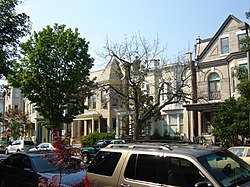Fan District
Fan Area Historic District | |
 A street in Fan | |
| Location | Roughly bounded by N. Harrison, W. Main, W. Grace and N. Mullberry Sts., Richmond, Virginia |
|---|---|
| Area | 228 acres (92 ha) |
| Architect | Multiple |
| Architectural style | Mid 19th Century Revival, Late 19th And 20th Century Revivals, Late Victorian |
| NRHP reference No. | 85002243[1] |
| Added to NRHP | September 12, 1985 |
The Fan is a district of Richmond, Virginia, so named because of the "fan" shape of the array of streets that extend west from Belvidere Street, on the eastern edge of Monroe Park, westward to the Boulevard. (Though the streets rapidly resemble a grid after moving through what is now VCU). The Fan is one of the easterly points of the city's West End section, and is bordered to the north by Broad Street and to the south by 195). The western side is sometimes called the Upper Fan and the eastern side the Lower Fan, though confusingly the Uptown district is located near VCU in the Lower Fan. Many cafes and locally owned restaurants are located here, as well as historic Monument Avenue. Development of the Fan district was strongly influenced by the City Beautiful movement of the late 19th century.
The Fan District is primarily a residential neighborhood consisting of late-nineteenth and early-twentieth century homes. It is also home to Virginia Commonwealth University's Monroe Park Campus, several parks, tree lined avenues and three of the city's historical monuments. The District also has numerous houses of worship, and locally owned businesses and commercial establishments. The Fan borders and blends with the Boulevard, the Museum District, and the Carytown district.
Main east-west thoroughfares include Broad Street, Grace Street, Monument Avenue, Patterson Avenue, Grove Avenue, Main Street and Cary Street.
Cultural
The Fan is a good example of a gentrified/gentrifying urban neighborhood. It was built as a neighborhood for the well-off, became rundown in they typical fashion of many US urban neighborhoods in the Twentieth century, and is becoming an almost exclusively well off neighborhood once again. Most current inhabitants are VCU students, upper middle class professionals, and empty-nesters. Monument Avenue remains a prominent residential area for Richmond's wealthy. Fan Real estate prices are well above those generally prevalent in the Richmond area. The Fan is also Richmond's Gay village and an important center of Richmond's social and nightlife. Most of the bars and restaurants are located on the Cary, Main, Robinson, Grace and Harrison street corridors, with others scattered somewhat randomly around the District.
Architecture


The Fan is often incorrectly described as significant for having one of the longest intact stretches of Victorian architecture in the United States,but most of it was actually built after the end of the Victorian era (Victorian Architecture) and is arguably more Edwardian and almost all of the housing stock was constructed in the first decades of the twentieth century and exhibits the pared back victorianism of Edwardian architecture. Colonial Revival and American Craftsman architecture is common as well, with Revival architectural types arguably the most common (as was common to the time period) Revivalism (architecture).
Primary architectural styles represented include:
Other architectural styles include:
- Tudor
- Second Empire
- Beaux-Arts
- Art Deco
- Spanish
- Gothic
- Bungalow
- American Arts and Crafts Movement
- James River Georgian
- Southern Colonial
- Jacobean
In April 2005, the Virginia Center for Architecture opened Branch House, an architecture museum on Monument Avenue. The Branch House was a historic Richmond home designed in 1918 by John Russell Pope as a reproduction of an English Tudor manor house.
History

In 1817, the Fan was plotted as the village of Sydney on land formerly owned by William Byrd II. Primary development of the Fan occurred after the Civil War through about 1920. Streetcar lines leading from downtown influenced development; the nation's first electric streetcar system was inaugurated in Richmond in 1888.
As development increased from downtown at the turn of the 20th century, Franklin street became a fashionable "West End" address. A desire for a West End address drove rapid real estate development of the area, changing the area from rural tobacco fields in 1900 to being almost fully developed land by the 1930s. As development accelerated, the University of Richmond (then located on Lombardy Street) was moved west to a more rural location (its present Westhampton location). During the Great Depression, many of the single-family homes in the area were converted to apartments.
The term "the Fan" was coined in the mid 20th century by a Richmond Times Dispatch editorial, as the appellation "West End" no longer applied.

